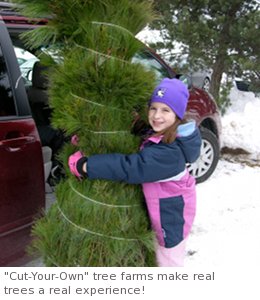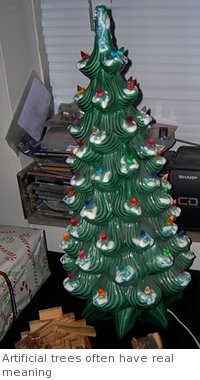Everyone loves the romance of having a real evergreen in the house, but is it just more work than it’s worth?
Reasons to Buy a Real Tree
Environment
“A Christmas tree farm is sort of like a very early forest to wildlife. Less mature forests have more wildlife,” says Jill Sidebottom, area extension specialist with mountain conifer and integrated pest management at North Carolina State University. She explains that creatures such as woodpeckers, shrews, bugs and field mice build habitats in the 25 square feet typically allotted per tree.
Made in the U.S.A.
Most nurseries buy trees from states within the U.S. For instance, Chalet in Wilmette purchases its Fraser, Balsam, Canaan and Noble Firs from Oregon, Wisconsin and Virginia. Many fake trees are imported, so when you buy a real one, you’re more likely to support the American economy.
 Fragrance
Fragrance
It’s hard to replicate the scent of a real Christmas tree. “A lot of people mention that they like the fragrance when they walk in the greenhouse,” says Patrick Whisler at Pasquesi Home and Gardens in Lake Bluff. He specifically notes the smell of Fraser Firs—the most popular variety he sells—and describes it as the quintessential Christmas scent. “Other greens smell similar, but it’s the strength of the fragrance and that fact that the Fraser stays fresh for so long.”
Tradition
For many families, buying a real tree cultivates a sense of tradition. “Everyone goes out and picks the perfect tree, sets it up and decorates it,” says Brian Wolff, nursery manager at Chalet. This ritual can spotlight the tree as the center of a family project in a way that doesn’t seem to hold true for artificial ones.
Reasons to Buy an Artificial Tree
Affordability
Last year the average American household spent $77 on a fake tree, or nearly double the $41 price tag of a real tree, according to the National Christmas Tree Association. With that cost differential, you can capitalize on your artificial tree investment as early as next Christmas.
 Time
Time
Consumers report that it can take as little as 3 to 15 minutes to set up an artificial, pre-lit tree—and that includes time spent getting the box out of storage! It’s hard to beat that kind of convenience, especially when you’ve got cookies to bake and stockings to stuff.
Cleanliness
Perhaps one of the biggest perks of a fake tree is the absence of fallen needles. For some, the sanitary benefits are a bit more extreme. “I grew up with real trees, but had to switch to fake when our male dog thought we had installed indoor plumbing for him,” says Carol Korak of Wilmette.
Legacy
Plastic trees can’t be recycled into mulch, but that doesn’t mean a fake tree has to end up in a landfill. Kristin Lanning, an Uptown resident, celebrates Christmas with a 50-year-old ceramic tree that belonged to her paternal grandmother. The tree honors the memory of her grandmother, whom Kristin describes as a strong single mother raising a son in 1950s Nebraska. “It’s a very special tree, even if it is ceramic,” she says.

